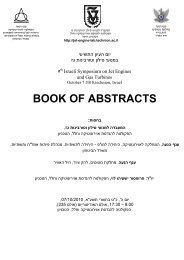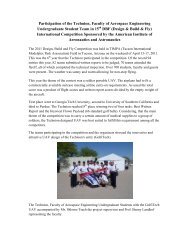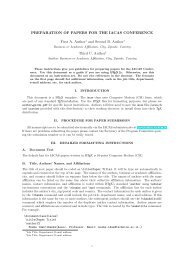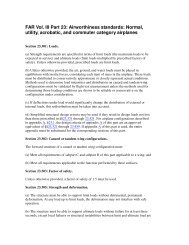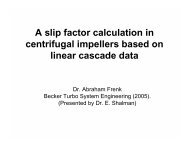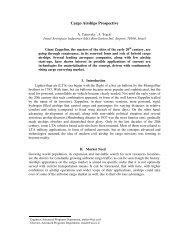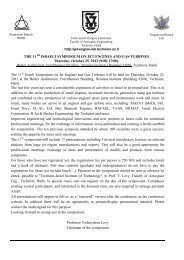A Century of Ramjet Propulsion Technology Evolution - Faculty of ...
A Century of Ramjet Propulsion Technology Evolution - Faculty of ...
A Century of Ramjet Propulsion Technology Evolution - Faculty of ...
Create successful ePaper yourself
Turn your PDF publications into a flip-book with our unique Google optimized e-Paper software.
Rustique (MPSR)/Rustique. The United States invested effort in supersonic<br />
low-altitude target (SLAT) and VFDR. During the 1990s,<br />
France continued its long history <strong>of</strong> development activity in ramjets<br />
with activity on MARS, MPSR/Rustique, Anti-Naivre Futur/Anti-<br />
Navire Nouvelle Generation ANF/ANNG, Vesta, and the nextgeneration<br />
ASMP-A. The People’s Republic <strong>of</strong> China began development<br />
<strong>of</strong> a long-range antiship variant (C-301) <strong>of</strong> its C-101 and<br />
the more advanced Hsiung Feng. South Africa began development<br />
<strong>of</strong> a long-range air-to-air missile (LRAAM). Russia continued to<br />
demonstrate its understanding <strong>of</strong> this technology by beginning the<br />
development <strong>of</strong> AA-X-12 and SS-N-26. Israel entered the ramjet<br />
community by beginning development <strong>of</strong> a ramjet-powered version<br />
<strong>of</strong> Gabriel for extended range. Germany began development <strong>of</strong> an<br />
antiradiation missile ARMINGER. India began development <strong>of</strong> the<br />
PJ-10/Brahmos, a derivative <strong>of</strong> the Russian SS-N-26. The 2000s<br />
have seen this development activity continue and expand yet further<br />
in the United States supersonic sea skimming target (SSST), generic<br />
supersonic cruise missile (GSSCM), and high-speed antirachation<br />
demonstration (HSAD), The United Kingdom beyond visual range<br />
air-to-air missile (BVRAAM/Meteor), France (MICA/RJ), and elsewhere.<br />
These and other international development programs are reviewed<br />
in further detail later in this paper as a means <strong>of</strong> better<br />
understanding the evolution in ramjet technology.<br />
Supersonic Combustion History<br />
Many excellent historical accounts chronicle international scramjet<br />
development. Curran provided a review <strong>of</strong> the first 40 years <strong>of</strong><br />
international scramjet engine development in 1997. 20 Waltrup reviewed<br />
international supersonic combustion development in 1987, 5<br />
and Waltrup et al. reviewed U.S. Navy scramjet and mixed-cycle engine<br />
development in 1996. 22 Van Wie 25 chronicled the 59-year history<br />
<strong>of</strong> JHU/APL contributions to the development <strong>of</strong> high-speed<br />
vehicles, highlighting five great APL propulsion pioneers, Avery,<br />
Dugger, Keirsey, Billig, and Waltrup in 2003. Andrews 26 provided<br />
avery thorough historical review <strong>of</strong> scramjet development and testing<br />
in the United States in 2001. McClinton et al. 28 provided a<br />
worthy review <strong>of</strong> engine development in the United States for space<br />
access applications in 2001. Escher 27 provided an excellent review<br />
<strong>of</strong> U.S. developments in combined airbreathing/rocket propulsion<br />
for advanced aerospace applications in 1999.<br />
Efficient airbreathing engines for operation into the hypersonic<br />
speed regime have been studied for over 40 years. The heart <strong>of</strong> these<br />
engine systems is the supersonic combustion ramjet (scramjet) cycle.<br />
Scramjet engine concept development, test facilities and instrumentation<br />
development, analysis method refinement, and component<br />
and engine testing have been pursued continually since the early<br />
1960s. Efforts to integrate the scramjet with higher and lower speed<br />
propulsion devices for space access have been investigated sporadically<br />
since the 1960s and continuously since 1984. McClinton et al. 28<br />
reviewed U.S. hypersonic airbreathing launch vehicle propulsion<br />
development efforts. The review addresses experiences and major<br />
accomplishments <strong>of</strong> historic programs; the goals, coordination between,<br />
and status <strong>of</strong> current programs in 2001; and a view <strong>of</strong> the<br />
future <strong>of</strong> hypersonic airbreathing propulsion development in the<br />
United States for future launch vehicles.<br />
In 2001 McClinton et al. 28 discussed scramjet development in<br />
the United States in terms <strong>of</strong> generations, first generation 1960–<br />
1973, second generation 1969–1984, third generation 1984–1994,<br />
and fourth generation from 1995-today. Each generation was<br />
distinguished by its unique contributions <strong>of</strong> the level <strong>of</strong> understanding<br />
<strong>of</strong> supersonic combustion.<br />
First Generation Scramjet Development (Beginning: 1960–1973)<br />
The origins <strong>of</strong> employing combustion in supersonic flows in the<br />
United States can be traced back to interest in burning fuels in external<br />
streams to either reduce the base drag <strong>of</strong> supersonic projectiles<br />
or to produce lift and/or thrust on supersonic and hypersonic airfoils<br />
in the early 1950s. 5 In Europe, interest in supersonic combustion<br />
paralleled that in the United States throughout the 1960s and<br />
1970s. The most extensive <strong>of</strong> the early (first generation) scramjet<br />
development programs in the United States was the NASA hyper-<br />
FRY 33<br />
sonic research engine (HRE) program. The HRE program, started<br />
in 1964, was crafted to develop and demonstrate flight-weight,<br />
variable-geometry, hydrogen-fueled and- cooled scramjet engine<br />
scramjet technology. In France, both fundamental and applied research<br />
was being pursued, with initial connected pipe testing being<br />
conducted by ONERA at Mach 6 conditions in the early 1970s. In<br />
Germany, most <strong>of</strong> the reported work was on supersonic combustion<br />
was <strong>of</strong>amore fundamental nature. Russia had an extensive program<br />
in supersonic combustion and scramjet propulsion since the<br />
1960s. Canadian interest in supersonic combustion began in 1960<br />
at MacGill University in hypersonic inlet aerodynamics and gunlaunched<br />
scramjet flight testing.<br />
The first Generation witnessed the start <strong>of</strong> several major scramjet<br />
development programs in the U.S. during the mid-1960s, following<br />
the first scramjet demonstration by Ferri in 1960 29 and studies<br />
that verified the benefits <strong>of</strong> scramjet propulsion. The U.S. Air<br />
Force, NASA, and U.S. Navy sponsored programs tested six scramjet<br />
engines/flowpaths through major contracts at Marquardt, General<br />
Electric, United <strong>Technology</strong> Research Center (UTRC), Garrett, and<br />
General Applied Sciences Laboratory (GASL). Engine flowpaths<br />
from all <strong>of</strong> these contractors were tested at low hypersonic speeds<br />
(up to Mach 7). Most tests utilized hydrogen fuel, but the U.S. Air<br />
Force also funded hydrocarbon-fueled scramjet tests for missile applications,<br />
and the U.S. Navy (APL) performed several different hydrocarbon<br />
studies in the Supersonic Combustion <strong>Ramjet</strong> (SCRAM)<br />
project. However, the U.S. Air Force withdrew from scramjet research<br />
and development, not to return until the National Aerospace<br />
Plane (NASP) program in 1984. Following successful demonstration<br />
<strong>of</strong> scramjet performance, operability and structural/systems integration,<br />
NASA turned to development and validation <strong>of</strong> airframeintegrated<br />
engine flowpaths.<br />
Second Generation Scramjet Development (Airframe Integration:<br />
1973–1986)<br />
The technology development focus in the United States shifted<br />
in the second generation to integration <strong>of</strong> hydrogen-fueled scramjet<br />
engines on a hypersonic vehicle following the first generation<br />
hypersonic propulsion demonstrators. A Mach 7 cruiser configuration<br />
was selected with turbojet low-speed and scramjet high-speed<br />
systems, in an over–under arrangement. NASA Langley Research<br />
Center (LaRC) led this effort, which focused on the sidewall compression<br />
scramjet engine. This engine included fuel injector struts<br />
and fixed geometry to minimize weight. Much <strong>of</strong> the research effort<br />
was placed on tool development. This included facilities, test<br />
methodologies, cycle analysis, data analysis, and computational<br />
fluid dynamics, (CFD). This time frame was also characterized by<br />
adownturn in research in the United States, and facility availability<br />
became an issue. Therefore, facilities were developed at NASA<br />
LaRC for efficient scramjet testing. Modest-sized facilities also remained<br />
available at GASL and were used to handle higher pressure<br />
validation tests. Component test facilities were also developed, including<br />
a combustion-heated direct-connect combustor facility and<br />
a Mach 4, high-pressure inlet test facility.<br />
Component tests were performed to establish rules-<strong>of</strong>-thumb<br />
design models/tools. These models 30 were not incorporated into<br />
the U.S. scramjet toolbox until the late 1980s. Component tests<br />
were also used to develop databases for verification <strong>of</strong> analytical<br />
and computational methods. These second generation cycle analysis<br />
methods are simplistic by today’s standards <strong>of</strong> CFD methods,<br />
nevertheless feature internal calculations such as shear and heat<br />
transfer to the combustor wall, fuel mixing, and estimated finite-rate<br />
chemistry effects on combustion. Scramjet tests for the three-strut<br />
engine were performed at NASA LaRC and GASL.<br />
Aerodynamic and propulsion-airframe integration (PAI) assessment<br />
is required to set scramjet performance requirements. Aerodynamic<br />
and PAI tests were performed to quantify inlet capture,<br />
external nozzle performance, and scramjet-powered vehicle performance.<br />
Aerodynamic wind-tunnel tests were performed at flight<br />
conditions up to Mach 8. Structural designs for the sidewall compression<br />
engine were developed, including primary structure, cooling<br />
jackets, and thermal management. These designs used cooling






